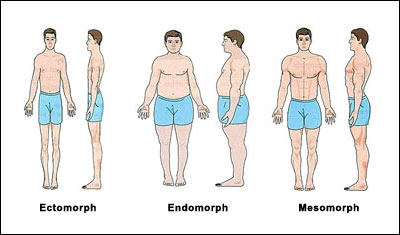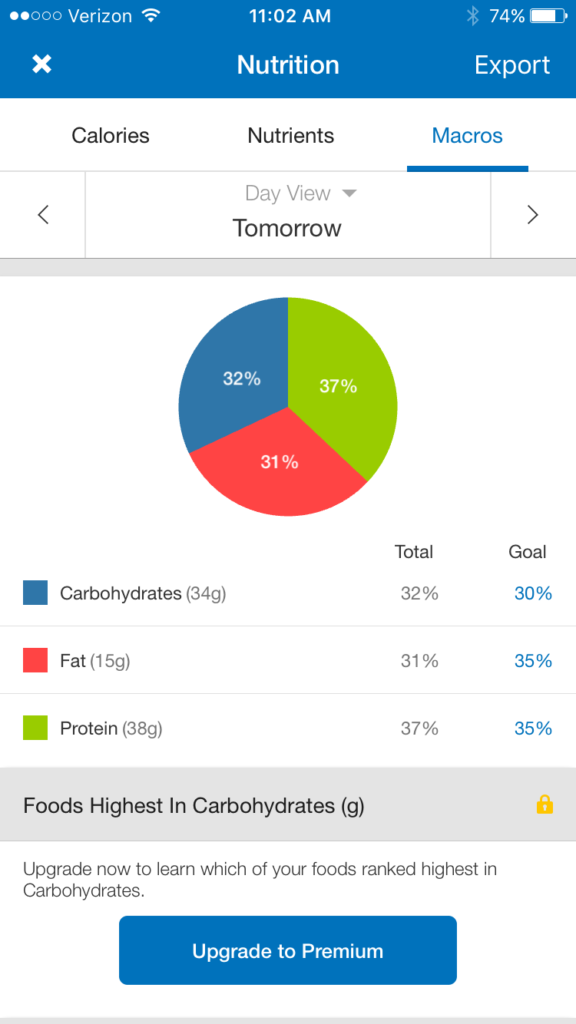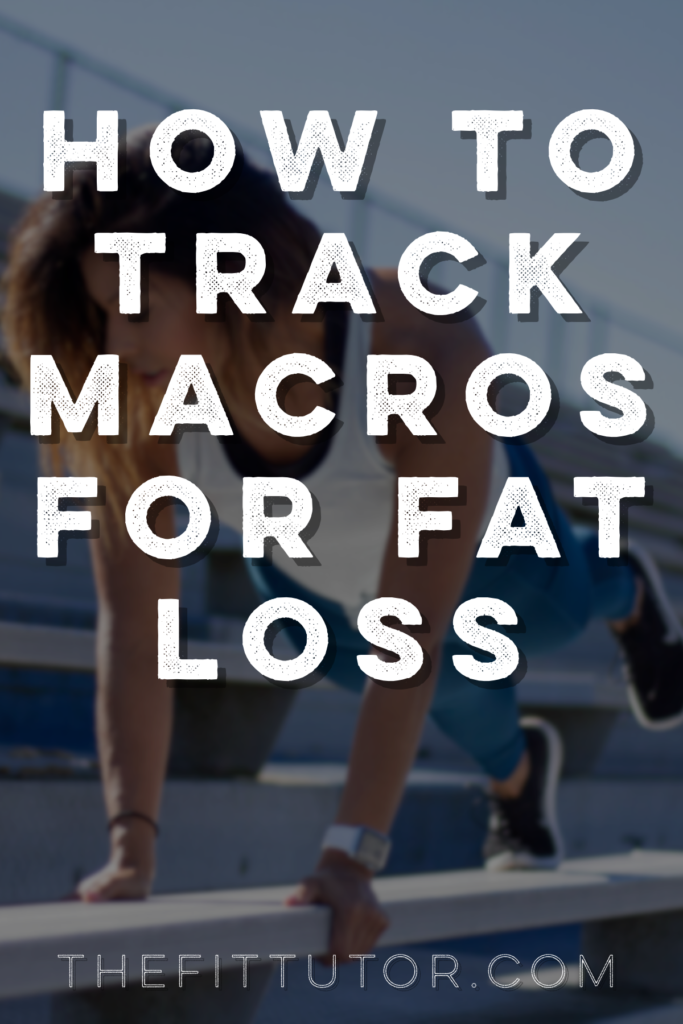Focusing on your macros can be a game changer for your weight loss and fitness goals. This article will walk you through the basics on how to alter your macronutrient percentages to get great results without feeling hungry!
In case you’re new to the macro game, when we say “macros,” fitness pros are usually referring to your percentages of fat, protein, and carbohydrates eaten for your total daily calorie intake.
Let’s say you eat 1,800 calories today. A certain percentage of those calories will be carbs, protein, and fats. We can alter those percentages so your macros are maximized for your goals- whether that’s gaining strength, losing fat, increasing endurance performance, etc.
This can be complicated, but it doesn’t have to be. I’ll explain how to do this, help you find your body type (and why that matters), and how to track macros for fat loss without it consuming your life!

Important Factors for Fat Loss
Before we dive into which macro percentage is best for you, let’s discuss the basics for fat loss. By the way, you don’t necessarily want weight loss, but fat loss. Trust me on this.
Calorie Deficit
A common goal of my clients is to “lose weight while toning up” — in other words, lose fat and gain strength. To do this, a person would need to create a calorie deficit. Weight loss isn’t as simple as calories in vs. calories out, but this is still pretty darn important! To create a calorie deficit, you should burn more calories than you consume.
- If you’re not sure how to get a calorie deficit, read this post!
To achieve this coveted calorie deficit, you can eat the amount of calories you need (based on these formulas) and step up your workouts to try to burn more calories than you consumed. Or, you can lower your calories consumed slightly to create your calorie deficit. However, eating enough to grow muscle but still get a calorie deficit to lose fat is much easier said than done! Lowering your calories too much can cause you to lose muscle instead of fat. This may look good on the scale, but not on your body.
Macro Percentages
Another option that often supports fitness goals better than just cutting calories is trying to consume certain percentages of each macronutrient.
By planning your diet around specific macronutrient percentages, you can eat more of the foods that help you burn fat, support your workouts, and gain muscle. It can also help keep you from retaining excess water. This should help the scale to play nice.
The rest of this post will focus on how to do this! First thing’s first, let’s discuss how to find your body type.
Discovering Your Body Type for Macro Percentages
My hubs and I had a very interesting conversation about body types and carbohydrates the other day. He’s used my “what your plate should look like” article to drop 10+ pounds in a month without exercise. Seeing him connect the pieces with body types and weight loss made me realize I needed to share this info more freely with others who might not know yet!
There are several theories about body types, but to keep it simple and effective, we will stick to three:
Ectomorphs
Ectomorphs are characterized by long and thin muscles and limbs. They are usually slim with low body fat storage. They tend to have a higher metabolism, good carb tolerance, and high sympathetic nervous system activity.
If you identify as an Ectomorph, here’s what the experts suggest you need for your body type:
- Protein: 25%
- Carbs: 55%
- Fat: 20%
This means that from your total calorie needs, 25% of those calories would come from protein, 55% from carbohydrates, and 20% from fat.
I’ll explain how to make this a reality in a bit, in case your brain is starting to hurt.
Mesomorphs
Mesomorphs have larger bones, a solid torso but a slim waist, wider shoulders, and usually have a controlled body fat percentage. They typically demonstrate a moderate carbohydrate tolerance, and moderate to high sympathetic nervous system activity. Mesomorphs are naturally muscular and athletic.
For a Mesomorph, your percentages should look something like this:
- Protein: 30%
- Carbs: 40%
- Fat: 30%
For this body type, you’ll need a little more protein and fat and fewer carbs.
Endomorphs
Endomorphs have wider waists, larger bones, and increased body fat storage. They are naturally broad and thick, and have a slower metabolism. In general, they do not tolerate carbs well, meaning they gain weight easily from them. They usually have low sympathetic nervous system activity.
If you identify as an Endomorph, your percentages should look something like this:
- Protein: 35%
- Carbs: 25%
- Fat: 40%
You’ll notice fat and protein are greatly increased compared to the other body types, and carbs are only at 25% of your total daily calorie intake.

Which One Are You?
Find which description matches your body. You could also be a combo, like an ecto-mesomorph who is athletic looking but still pretty slim, or an endo-mesomorph who is strong but carrying extra fat. If you feel like you are a combo, you can tweak the percentages to fit your needs.
Choose Based on Descriptions or Your Goals
You don’t have to follow the percentages listed for your body type. In fact, you may get better results by following macro percentages based around your goals.
For Fat Loss
If your main goal is to lose fat, I usually recommend clients go with the endomorphic recommendations, even if you’re not sure you fit that description. When I want to lose some weight, I’ll cut my carbs a bit and increase my fat and protein to help me get there.
Depending on your actual body type, you may not be able to handle lower carbs for that long. I’m an ecto-mesomorph and I gain weight with high carbs, but find myself extremely anxious with only 25% carbs. I’ve had to work to find a happy middle- but the results have been worth it!
Following the endomorphic percentages helped someone lose 11 inches in three weeks in my last fitness challenge. They work!
For Performance Goals
If your top priority is endurance performance, then go with the ectomorphic percentages. If your primary goal is to gain muscle, you can can start with ectomorphic percentages and adjust after a few weeks.
If strength and power performance are your biggest goals, then opt for the mesomorphic percentages. Or just simply go with whatever body type describes you.

How to Get Specific with Calculations
OK, so if you’re like me, your brain is already overwhelmed by the word “calculation.” I’m going to show you how to do this, but have no fear. There’s an easier way that’s less time consuming. But it’s helpful to know the basics first!
And you’re welcome to just jump to the next section if there’s no way in hell you’re going to calculate these for yourself ;)
How Many Calories Should You Consume From Each Macro?
Once you have identified your calorie goals, body type, and macro percentages, you can find out how many calories should come from each macronutrient.
- Protein has 4 calories per gram
- Carbohydrates have 4 calories per gram
- Fat has 9 calories per gram
Let’s look at an example. Rebecca is allotted 1800 calories per day. If she is trying to lose weight, she will adopt the endomorphic percentages, which are Protein: 35%, Carbs: 25%, and Fat: 40%.
To figure out how many calories should come from each macronutrient, take your total calorie intake and multiply it by the goal percentage for each macro.
- Rebecca’s goal for protein is 35%, so she will multiply her total calorie intake by 0.35
- 1800 x 0.35 = 630 calories from protein
- Her goal for carbohydrates is 25%, so she will multiply her total calorie intake by 0.25
- 1800 x 0.25= 450 calories from carbs
- Finally, her goal for fat is 40%, so she will multiply her total calorie intake by 0.40
- 1800 x 0.40= 720 calories from fat
Turning Calories Into Grams
These stats might not mean much to you. To make them more usable, we need to turn the calories into grams, which are easier to track! To do this, divide your total number of calories for each macronutrient by their calories per gram. Back to our example:
- Rebecca can consume 630 calories from protein. She divides 630 by 4 = her goal is 157 grams of protein
- Carbs: 450/4 = 112 grams of carbs
- Fat: 720/9 = 80 grams of fat
Once you have these valuable numbers, you can track your calories and monitor how many grams you consume of each macronutrient. Adjust intake as necessary. Or, you can make a meal plan based around these macro percentages.
But This Sounds Hard and Time-Consuming…
Yes, tracking can be very tedious. I just wrote up two other articles about calorie counting that may help you
In the second, I mention the strategy I use with many clients- track for a week and use that data to make adjustments. You can do the same with macros!
Use an App to Make this Easier
Any good calorie counting app should show you your macro percentages as you track. Instead of counting each gram, you can simply look at this information after your last meal and adjust for your next one, or at the end of each day and learn to adjust your eating accordingly.
You can adjust without worrying about the specific number of grams. For example, if you notice your carbohydrate content is really high after lunch, try to have a dinner that’s high in protein and fat to balance your macros out. Or, at the end of the day, if you discovered you consumed way too little protein, make that your priority tomorrow.
I use MyFitnessPal, and you can click on their “Nutrition” button and it will show you your actual macro percentages compared to your goal percentages so it’s easy to know how to adjust.

You Can Benefit from Macro Percentages Without Tracking Every Gram
You don’t have to count every gram to see results. Now, it might be helpful to do for a week or so, or if you feel like you’re doing everything right but the scale isn’t budging. Counting calories and tracking macros can be very valuable, but for most people it’s too tedious and time-consuming. I rarely ever count my macro grams and still feel fueled for my workouts and am getting the results I want.
Disclaimer: I might get my results faster if I was willing to track. But… life.
I recommend people track their food in an app that will calculate their macros for them, and do that for at least a week. Repeat as often as necessary for accountability and seeing what you need to adjust!
My other recommendation is this:
How to Eyeball Macro Percentages
Here’s what I do regularly: I follow the Hand Portion Guidelines described in this article
By using this portion control method, you’ll usually eat around the equivalent of the Endomorphic percentages. You can add or cut carbs as needed for your body type and exercise needs- it’s so easy to personalize. By planning your meals around this portion guide, you can get results without tracking calories or macros.
But What About the Calorie Deficit?
So, here’s where your portions don’t lie. If you’re eating too much and your results are lacking, then decrease your portions slightly to ensure a calorie deficit. Or, if you love snacking on something that “technically” meets your macros/hand portions but is crazy-high in calories, swap it out for something better. If your go-to “fat” is peanut butter, try changing it up for a lower-cal fat source to help you reach your goals.
If you feel like your macros and portions are what they should be based on this guide, then it would be helpful to track for a week and find any outliers that are throwing off your counts. Find a healthier replacement and your scale should start moving in the right direction!
And to really keep track of your true consistency with these healthy habits, may I suggest using a habit chart? ;)
How to Simplify the Process and Speed up Your Results
I know this sounds so tedious, and we’ve all either rolled our eyes at or been that person talking excessively about their macros. If you want your mental space to be freed up from thinking about food as numbers or using your valuable time to calculate fat grams in food, I suggest you find a macro-based meal plan that works for you.
Here are some good options:
You can leave it to the pros, who have already created meal plans based on these macros and calorie counts. Better yet, hire someone to plan out a month’s worth of healthy meals that you personally would love to eat based around your desired macro percentages and calorie needs. It makes your life so much easier + the cost is definitely worth it. Consider it an investment in your health that you get to re-use over and over again!
Fitness Challenge with Meal Plans for Weight Loss
I’m launching an Online Fitness Challenge that would be perfect for anyone wanting to get started in eating macros for fat loss. It will include 8 weeks worth of meal plans, shopping lists, and food prep guides so all you have to do is follow along. It takes away the thinking and stress and makes macros (and fat loss) easier to make happen! This is a more affordable way, since group coaching costs less and the included workouts will give you the best results in that time frame!
You can also try to plan your own meals around the hand portion guide mentioned above. If you’ve struggled with fat loss in the past or feel really hungry and uncomfortable when you cut calories, this is a great thing to try! Diets don’t really work…. most people gain the weight back, and you’re probably not above those statistics (gasp)! It’s so helpful to just learn how to eat right and do this consistently so you’re always looking and feeling your best!
I highly recommend giving this way of eating a try!
What other questions do you have about macros or calories? Ask in the comments and I’ll try to turn some into another article. Thanks!
I’d suggest talking with your doctor or a nutritionist before switching up your diet, especially if you have a history of kidney disease.



Comments are closed.